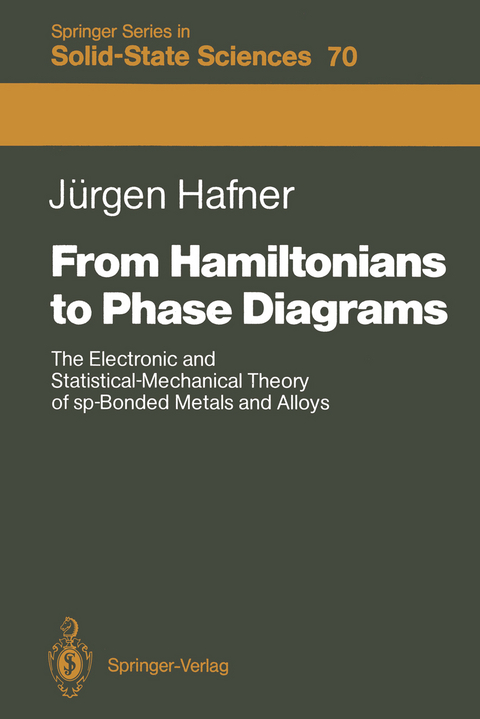
From Hamiltonians to Phase Diagrams
Springer Berlin (Verlag)
978-3-642-83060-0 (ISBN)
1. Introduction.- 1.1 Why This Book Was Written and What It Contains.- 1.2 The Thermodynamic Origin of Phase Diagrams.- 1.3 Adiabatic Decoupling of the Ionic and Electronic Degrees of Freedom.- 1.4 The One-Electron Approximation.- 1.5 Tightly-Bound and Nearly-Free Electrons; Potentials and Pseudopotentials.- 1.6 Response Theory and Interatomic Interactions.- 1.7 The Statistical Mechanics of a Vibrating Lattice.- 1.8 Periodic, Aperiodic and Quasi-Periodic Structures.- 1.9 Elementary Excitations in Aperiodic Structures.- 1.10 Configurational Thermodynamics of Solids and Liquids.- 2. Interatomic Forces in Metals and Alloys.- 2.1 Pseudopotentials.- 2.2 Response Theory.- 2.3 Effective Pair Potentials in Pure Metals.- 2.4 Effective Pair Potentials in Binary Alloys.- 2.5 Interatomic Forces in Non-Simple Metals and Alloys.- 2.6 Beyond Perturbation Theory.- 3. Phase Stability of Crystalline Metals.- 3.1 Simple-Metal Cohesion.- 3.2 Structural Stability.- 3.3 Trends in Crystal Structures.- 3.4 Pressure-Induced Phase Changes.- 3.5 Thermodynamics of Crystalline Metals.- 3.6 Temperature-Induced Phase Changes.- 4. Structure and Thermodynamics of Liquid Metals.- 4.1 Computer Simulations.- 4.2 Integral Equation Approach.- 4.3 Thermodynamic Perturbation Theories.- 4.4 Trends in Liquid Structures.- 4.5 Expanded Fluid Metals.- 4.6 Structure and Thermodynamics of Liquid Transition and Rare-Earth Metals.- 4.7 Atomic Motion in Liquid Metals.- 5. The pT Phase Diagram of Pure Metals.- 5.1 Solid-Liquid Trnasitions: The Total Energy Approach.- 5.2 Microscopic Theories of Melting and Freezing.- 5.3 The Liquid-Vapour Transition.- 6. Alloy Formation and Stability.- 6.1 Nearly-Free-Electron Approach to Alloy Formation.- 6.2 Miedema's Semiempirical Theory of Alloy Formation.- 7. Solid SubstitutionalAlloys.- 7.1 Primary Solid Solutions.- 7.2 Hume-Rothery Phases.- 7.3 Static Lattice Distortions.- 7.4 Ordering in Substitutional Alloys.- 7.5 Thermodynamics of Alloys.- 8. Intermetallic Compounds.- 8.1 Structure Maps.- 8.2 Empirical Pair-Potential Analysis of Intermetallic Phases.- 8.3 Classification of Intermetallic Phases According to Building Principles and Properties.- 8.4 Topologically Close-Packed Intermetallic Compounds (Frank-Kasper Phases).- 8.5 Intermetallic Phases with Large Band-Structure Stabilization.- 9. Liquid Alloys.- 9.1 Computer Simulations of Binary Liquid Alloys.- 9.2 Thermodynamic Variational Calculations.- 9.3 Thermodynamic Perturbation Theory.- 9.4 Structure and Thermodynamics of Liquid Transition-Metal Alloys.- 9.5 Collective Excitations in Liquid Alloys.- 10. Alloy Phase Diagrams.- 10.1 First Principles Calculations of Alloy Phase Diagrams.- 10.2 Chemical Short-Range Order and Alloy Phase Diagrams.- 10.3 Molecular Theory of the Freezing of Liquid Alloys.- 11. Beyond the Phase Diagram: The Formation and Properties of Metastable Phases.- 11.1 Amorphous Alloys - Metallic Glasses.- 11.2 Quasi-Crystals.- 12. Conclusions and Outlook.- Appendices.- A. Density-Functional Pseudopotentials.- A.1 Optimized Pseudopotentials - the Operator Approach.- A.2 Norm-Conserving Pseudopotentials - the Scattering Approach.- B. Linear Response Theroy.- C. Electrostatic Energies of Crystals and Liquids.- C.1 The Madelung Constants of the Elemental Structures.- C.2 The Madelung Constants of Binary Alloys and Intermetallic Compounds.- C.3 Electrostatic Energies of Model Liquids and Liquid Mixtures.- D. Liquid State Theory: Integral Equations, Variational Principles and Exactly Soluble Models.- D.1 Correlation Functions and Equations of State.- D.2 IntegralEquations and Variational Principles for the Total and Direct Correlation Functions.- D.3 Analytical Solutions for Model Liquids and Mixtures.- D.3.1 Solution of the PY Equation for the Hard-Sphere Fluid.- D.3.2 Solution of the PY Equation for Hard-Sphere Mixtures.- D.3.3 The Solution of the MSA for Charged Hard Spheres with Yukawa Interactions.- D.3.4 The Solution of the MSA for a Symmetric Mixture of Charged Hard Spheres with Yukawa Interactions.- References.
| Erscheint lt. Verlag | 15.12.2011 |
|---|---|
| Reihe/Serie | Springer Series in Solid-State Sciences |
| Zusatzinfo | XI, 404 p. |
| Verlagsort | Berlin |
| Sprache | englisch |
| Maße | 152 x 229 mm |
| Gewicht | 604 g |
| Themenwelt | Naturwissenschaften ► Physik / Astronomie ► Atom- / Kern- / Molekularphysik |
| Naturwissenschaften ► Physik / Astronomie ► Festkörperphysik | |
| Technik ► Maschinenbau | |
| Schlagworte | Cohesion • Crystal • crystal structure • Intermetallic compound • scattering • thermodynamics |
| ISBN-10 | 3-642-83060-9 / 3642830609 |
| ISBN-13 | 978-3-642-83060-0 / 9783642830600 |
| Zustand | Neuware |
| Haben Sie eine Frage zum Produkt? |
aus dem Bereich


